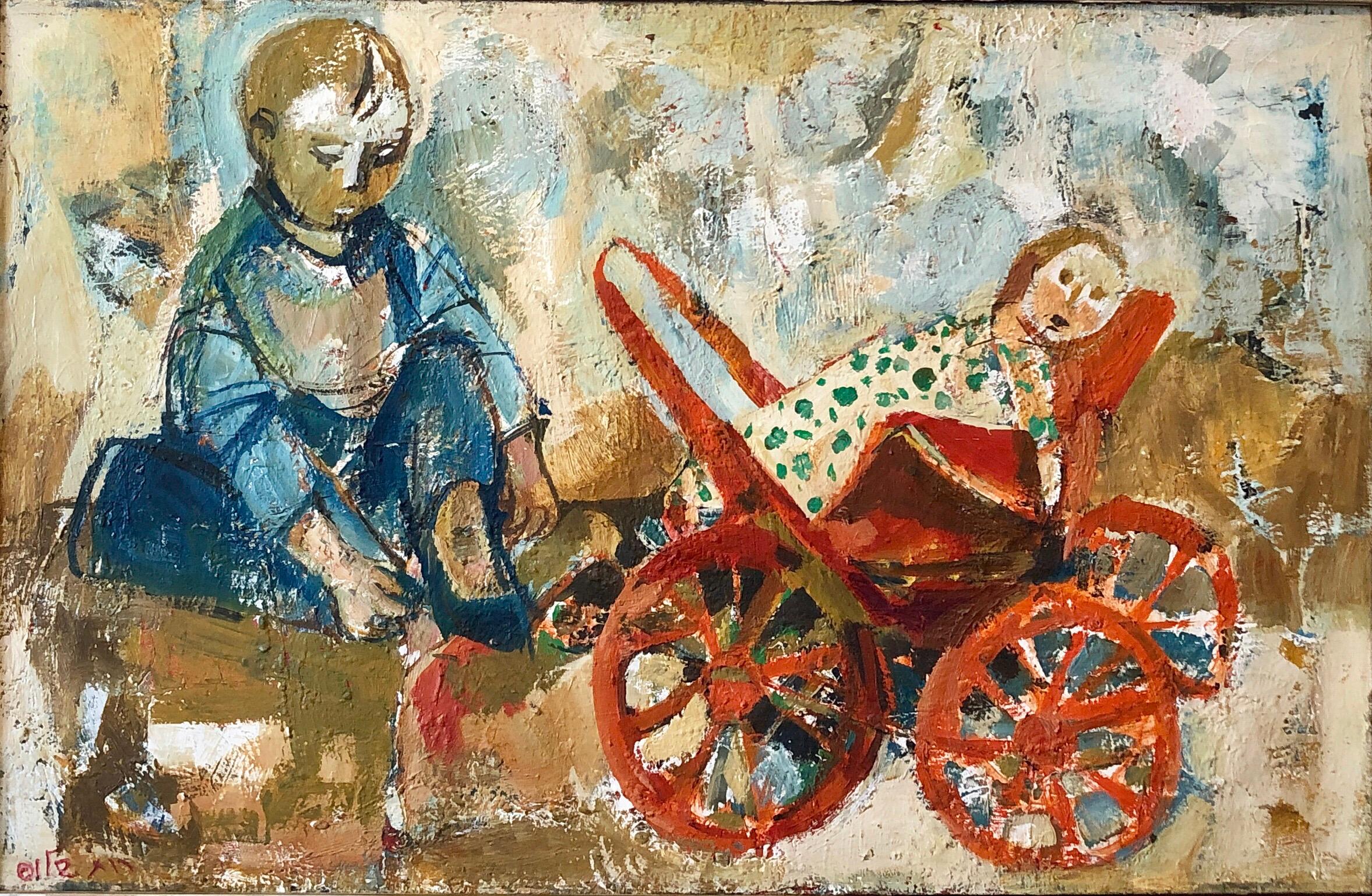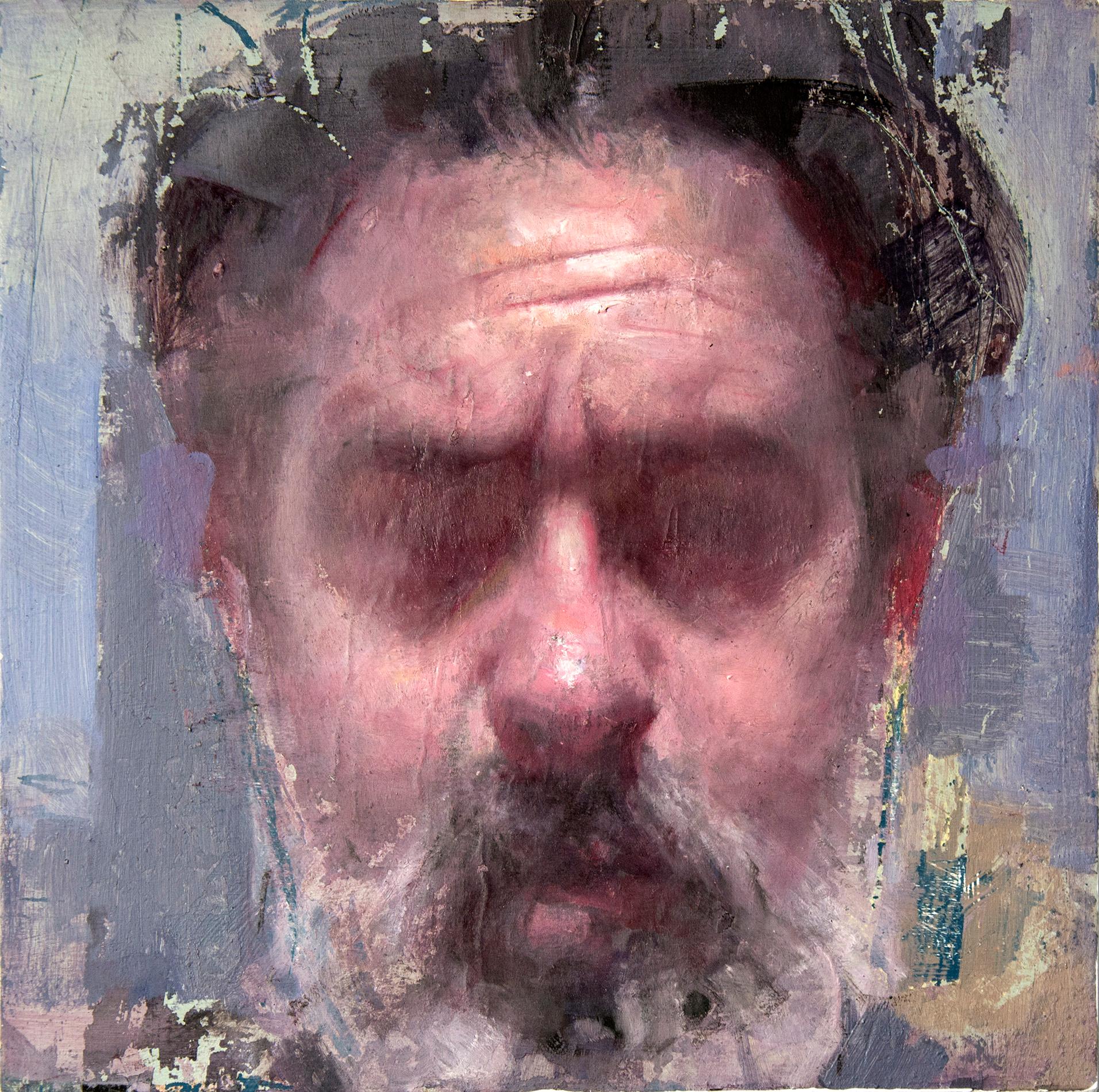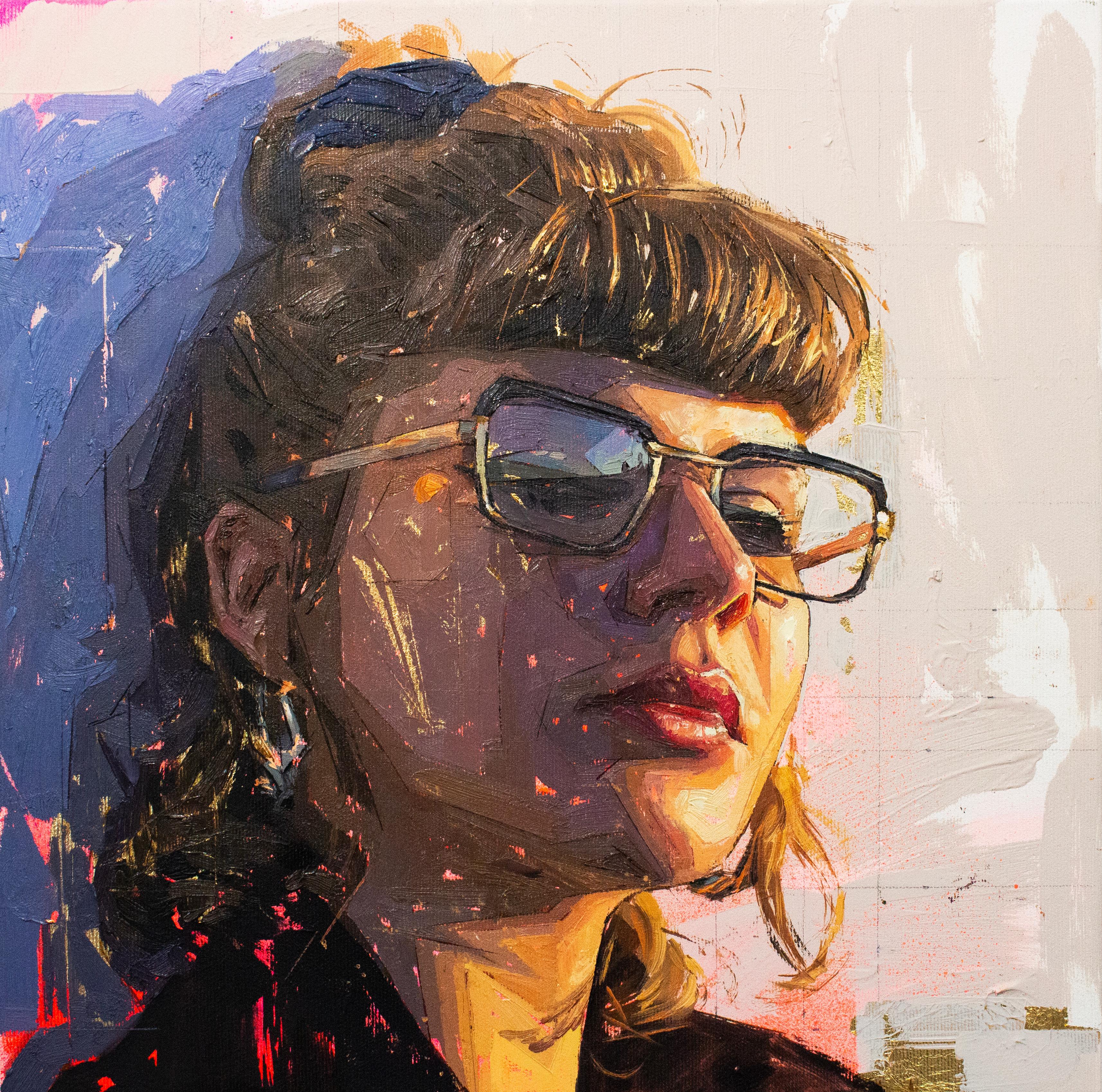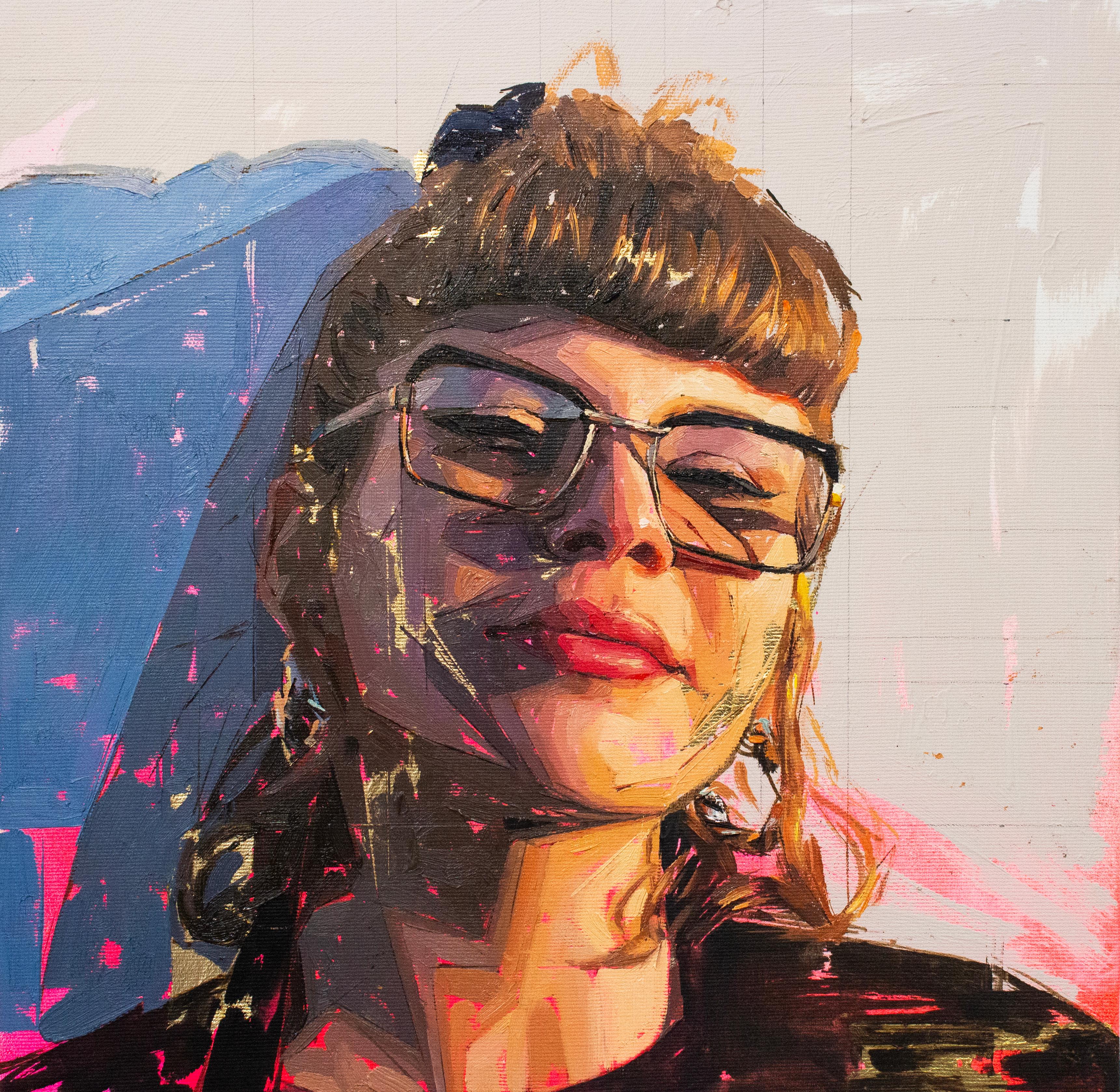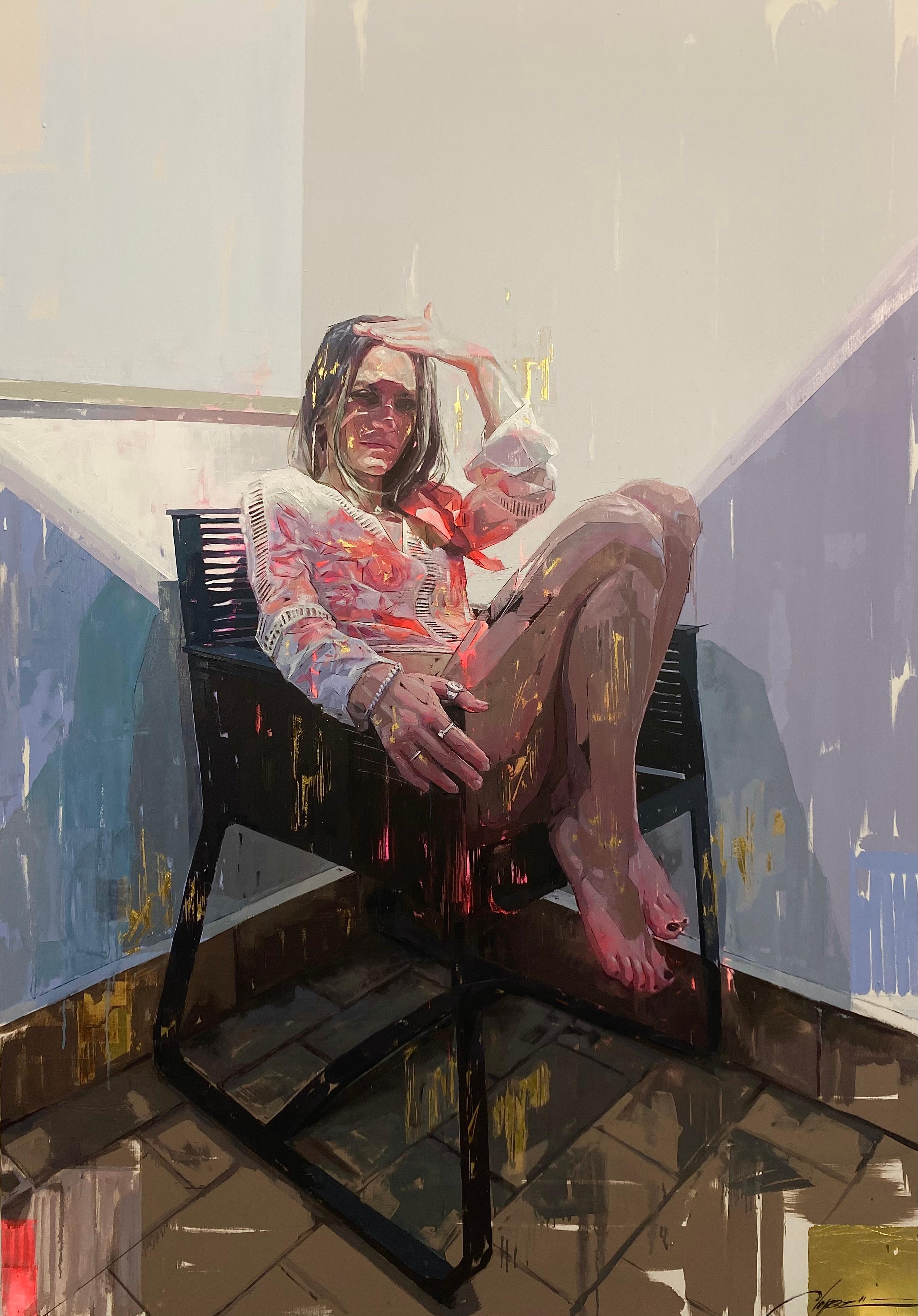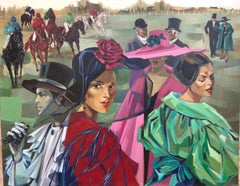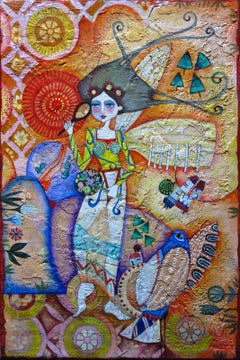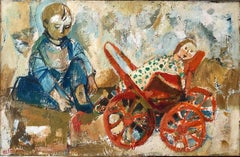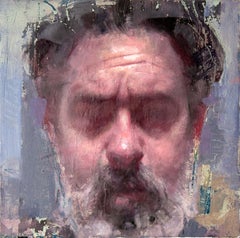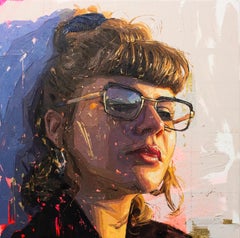Items Similar to Spanish Contemporary Woman Portrait Lying On The Couch. Figurative Realism.
Want more images or videos?
Request additional images or videos from the seller
1 of 19
Ospina OrtizSpanish Contemporary Woman Portrait Lying On The Couch. Figurative Realism.
About the Item
¨Serenidad¨. Spanish Contemporary Woman Portrait Lying On The Couch. Figurative Realism.
Oil on canvas.
Dimensions: (H) 130x (W) 162 x (D) 2 cm. / Inches 51.18 x 63.78 x 0.79 "
Framed: (H) 153 x (H) 185 x (D) 4 cm. / Inches 60.24 x 72.83 x 1.57 "
Juan Carlos Ospina Ortiz (Colombia 1963), practices realistic figuration with themes of clear Spanish influence. The artist settled in Andalusia (Spain), where, searching for his roots, he immersed himself in the music, folklore, and traditions of that country.
This painting, ¨Serenidad¨, is reproduced on a double page in the article that the renowned art publication Prestige Magazine edited in 2003, where the cover is a female portrait by Ospina Ortiz. (number 63, 2003, pages 24-25).
ABOUT THE ARTIST
Juan Carlos Ospina Ortiz (Tolima-Colombia 1963) studied design and painting in Bogotá, which he later complemented with specializations in Paris and Madrid. He practices a realistic figurative style, where he alternates between portraits, still lifes, landscapes and horse paintings.
In 1993 he visited Spain for the first time, being greatly influenced by two renowned contemporary painters: Antonio López and Eduardo Naranjo. His works, from those years on, would be strongly influenced by the vision he had of them. He obtained a scholarship to continue his training with the Colombian painter Guillermo Muñoz Vera, director and founder of the Arauco Foundation, in Madrid.
Ospina Ortiz has participated in group and individual exhibitions in different cities in Spain, France, Holland, Ireland, England, the United States, Canada, United Arab Emirates, China and Colombia.
In 2003, The Spanish Philatelic Postal and Telegraphic Service issued a beautiful series of six self-adhesive stamp depicting reproductions of six paintings by Ospina Ortiz which have still-lives as a common theme.
About the Seller
5.0
Vetted Professional Seller
Every seller passes strict standards for authenticity and reliability
Established in 2002
1stDibs seller since 2017
66 sales on 1stDibs
- ShippingRetrieving quote...Shipping from: Trescasas, Spain
- Return Policy
Authenticity Guarantee
In the unlikely event there’s an issue with an item’s authenticity, contact us within 1 year for a full refund. DetailsMoney-Back Guarantee
If your item is not as described, is damaged in transit, or does not arrive, contact us within 7 days for a full refund. Details24-Hour Cancellation
You have a 24-hour grace period in which to reconsider your purchase, with no questions asked.Vetted Professional Sellers
Our world-class sellers must adhere to strict standards for service and quality, maintaining the integrity of our listings.Price-Match Guarantee
If you find that a seller listed the same item for a lower price elsewhere, we’ll match it.Trusted Global Delivery
Our best-in-class carrier network provides specialized shipping options worldwide, including custom delivery.More From This Seller
View AllBefore The Horse Race. Jori Duran expressionist high society sport scene
By Jori Duran
Located in Segovia, ES
"Before The Horse Race" (Avant la course), expressionist high society spot scene, Oil on Canvas.
Dimensions: (H) 65 x (W) 81 X (D) 3 cm.
Jori Duran (J...
Category
21st Century and Contemporary Expressionist Figurative Paintings
Materials
Oil, Canvas
Regattas day (a tribute to Seurat). Large format Riverside scene with figures.
By Fabio Hurtado
Located in Segovia, ES
Reggatas day (tribute to Seurat), by Fabio Hurtado, is an oil painting on canvas which was created in 1995 and which obtained the Honorary Medal at the C...
Category
1990s Art Deco Figurative Paintings
Materials
Canvas, Oil
Primavera en jardín (Spring in garden). Post-impressionist female figure sitting
By Joan Raset
Located in Segovia, ES
Primavera en jardín ( Spring in garden).
Oil on canvas by Spanish artist Joan Raset.
Dimension with frame 104 cm H x 121 cm W x 4,5 cm D
Dimension without frame 73 cm H x 92 cm W x 2...
Category
Early 2000s Post-Impressionist Figurative Paintings
Materials
Canvas, Oil
$4,178 Sale Price
20% Off
"Back". Raquel Fariñas symbolic and colorful Folk Art style painting
By Raquel Fariñas
Located in Segovia, ES
"Back" (De vuelta). Acrylic on canvas.
Dimension: 30 cm x 20 cm x 2 cm / Inches: 11.81 x 7.87 x 1.58 "
The pictures of Raquel Fariñas are presented ...
Category
2010s Folk Art Figurative Paintings
Materials
Canvas, Acrylic
I adore your boogies-woogies. Figurative painting with popular dancers and music
By Igor Fomin
Located in Segovia, ES
I love your “Boogies-woogies”, (Adoro tus "Bugisvugis"). Figurative painting with popular dancers and musicians.
Acrylic on canvas.
Measurements in centimeters: 97 x 130 x 3 cm. Fram...
Category
Early 2000s Modern Figurative Paintings
Materials
Canvas, Acrylic
$13,868 Sale Price
20% Off
Kostacis with his hummingbirds Figurative popular scene in a Renaissance setting
By Igor Fomin
Located in Segovia, ES
Kostacis with his hummingbirds. Figurative popular scene in Renaissance atmosphere.
Acrylic on canvas.
Dimensions in centimeters 81 x 100 x 2 cm. Framed 105 x 124 x 5 cm.
Dimensions In inches: 31.89 x 39.37 x 0.79 " . Framed 41.34 x 48.82 x 1.97 "
Kostacis with his hummingbirds. Figurative Popular scene in Renaissance atmosphere.
Acrylic on canvas.
Outside scene where a group of people seem to experience extraordinary sensations surrounded by hummingbirds.
In an urban environment with a Renaissance flair, the characters, dressed in original clothes of plural inspiration, seem to react ecstatically by the effects of the hummingbirds, which Kostacis seems to have under control with his wealthy and wise aura.
The studied composition, the chromatic harmony, and the subtlety of the design of all the elements that make up the scene, give this painting a classic beauty. The author adds to all this his own brushstrokes of fine humor that wrap the whole theme in a casual irony, the same which surrounds all the stories that Igor Fomin...
Category
Early 2000s Modern Figurative Paintings
Materials
Canvas, Acrylic
$12,099 Sale Price
20% Off
You May Also Like
Israeli Oil Painting Ruth Schloss Child, Doll, Wagon, Kibbutz Social Realist Art
By Ruth Schloss
Located in Surfside, FL
Large magnificent colorful Ruth Schloss oil painting of a child with a wagon with a doll or a baby in a carriage stroller.. Signed in Hebrew
size measures 31x43 with frame , 23x35.25 without the frame. (this is being sold unframed).
Ruth Schloss (22 November 1922 – 2013) was an Israeli painter and illustrator who mainly depicted neglected scenes such as Arabs, transition camps, children and women at eye-level as egalitarian, socialist view via social realism style painting and drawing.
Schloss became Israeli painting’s sensitive, conscious, remembering eye.
Ruth Schloss was born on 22 November 1922, in Nuremberg, Germany, to Ludwig and Dian Schloss, as the second of three daughters of bourgeois assimilationist Jewish family well-integrated into German culture. As the Nazis came into power in 1933, her family immigrated to Israel in 1937, and settled in Kfar Shmaryahu, then an agricultural settlement. Schloss studied at the Department of Schloss graphic design at "Bezalel" from 1938 to 1942 alongside Friedel Stern and Joseph Hirsch. She was a realistic painter who focused on disadvantaged people in the society and social matters as an egalitarian. Her realism was thus an “inevitable realism,” motivated by an inner necessity: the need to observe reality as it is.
Her painting repeatedly addressed the door pulled from its frame, employing drawing’s unique ability to stop time and prolong the image’s persistence in the retina, she repeatedly committed to paper - in a matter-of-fact, non-evasive manner devoid of mystery – man’s tendency to generate chaos, suffering and pain.
Throughout her life, Schloss remained minimalist. Painting about human fate was the main subject of her artworks. Her natural inclination was to describe the darker aspect of human existence.
1930s
The Schloss household was characterized by open, liberal spirit, in keeping with the parents’ progressive views. It deeply influenced Ruth’s mental development, as she learned to tie culture and art with sensitivity towards the weak and underprivileged.
In Jerusalem, she joined a commune of Hashomer Hatzair in which she shaped her socialist views, which she maintained throughout her long career.
1940s
In this period she mainly depicted landscapes of kibbutz and wretched women living hard life, children in huger, older people, refugees. After completing her art studies, Schloss joined a training group at Kibbutz Merhavia in 1942, and after two years moved to Karkur region, the nucleus established Kibutz Lehavot Habashan in the Upper Galilee. Through this time, she fell in love with the surroundings and drew landscapes. They are simple and direct with fresh, lucid lines. These paintings were selected as the main works of her first exhibition in 1949.
In early 1945, Schloss started to draw illustrations in the children’s magazine Mishmar Leyeladim, and designed the logo of Al Hamishmar, the paper’s new name in 1948. In 1948, upon the founding of Mapam (United Workers’ Party), she designed her party’s emblem, which became a well-known icon. She kept working as an illustrator for Mishmar Layeladim until 1949.
"Mor the Monkey" project yielded financial profits and this income was used for a study trip to Paris for two years. She was succesfull as illustrator however, she had inner conflicts of her identity as witnessed painter toward neglected class in Israeli society.
First Exhibition at Mikra-Studio Gallery, 1949
She presented forty drawings on paper in her first solo exhibition, representing a selection of the themes of kibbutz landscape, its lifestyle. Schloss confidently proposed her direction through simplicity without using colors in her drawings.
1950s
Between 1949 and 1951, she studied at the Académie de la Grande Chaumière in Paris.
She began working in oils, with which she continued throughout the 1960s.
The exhibition “Back from Paris” opened in November 1951 at Mikra-Studio Gallery .
In 1951 she married Benjamin Cohen, who served as chairman of the national leadership of Hashomer Hatzair Workers Party in Tel Aviv. He was a theoretician and a man of principle, highly esteemed by its leaders who became a professor of history at Tel Aviv University. In 1953, following the Mordechai Oren affair and the publication of Moshe Sneh 's followers from Kibbutz Artzi, she and her husband left the kibbutz and moved to the agricultural farm, Kfar Shmaryahu, where she lived until her death.
At a certain point in Israeli history, segments of the socialist movement felt that Israel should become part of the Communist bloc, rather than seek the support of the western world. Because the Schloss couple support of Moshe Sneh’s left-wing party, they had to leave the kibbutz.
She loved to depict ordinary women as figurative on her painting without hiding or making up anything. The poet Natan Zach wrote about her works in 1955: “Her motto remains that which has been all these years: life as it is, without bluffing."
Schloss’s “Pietà” (1953) became a universal cry expressing the pain of mothers on either side of the divide. In the late 1950s, she was the mother of two daughters. When she drew her daughters, unlike the universal babies she depicted, naked and with clenched fists, the painting of her children employed babyish sweetness to the full in a quiet, peaceful and heart-stirring filling rather than urgency. She also painted children in the transition camp and Jaffa in the 1950s and 1960s.
1960s-1980s – The period of Studio in Jaffa
Schloss painted at a studio in Jaffa from 1962 till 1983. In this time, she turned her interest to people around her more than kibbutz – the children, mothers, and poor workers, the alleys and houses. She opened the space to the street and its dwellings, built interactions around it, and was nurtured by the presence of the outside in her work.
1960s Schloss familiarized to an Arab woman, Nabava, lived in poor. Schloss returned to painting images of old people later, and she called her painting figurative elderly people in the old age homes “waiting”.
In the late 1960s, Ruth discovered acrylic paint and never turn back to oil painting.
In 1965 Schloss devoted a series “Area 9 (1965)”, dedicated to the demolition of Israeli-Arab houses and the expropriation of the land, and carried a definite socio-political messages. The series was exhibited at Beit Zvi, Ramat Gan, in 1966. She was the only artist who addressed the result of the Six-Day War immediately afterward. In 1968, Schloss and Gansser-Markus presented “Drawing of War” in Zurich gallery. She expressed the war as an ultimate expression of destruction and ruin, regardless of victors and vanquished.
1970s In late 1970s Schloss began printing the selected photograph directly on the canvas, posterior reworking it in acrylic. She decided to print her work at Har-El Printers in Jaffa, and these became the surface of her painting. This technique was mainly adopted in two large series: Anne Frank (1979-1980) and Borders (1982). Through this technique she placed the figure of elder Frank next to that of the famous young Frank, and released it at the exhibition at Bet Ariela Cultural Center, Tel Aviv, in 1981. The series touched upon the Nazi Holocaust.
1980s The Lebanon War raised the question of “The Good Fence” and the effect of the war. She dedicated a large series Boarders, one of the most powerful image linked to the series is the figure of Yemenite woman raising her hand. She was the first to raise the Black Panthers demonstration to the level of a social icon. In the 1980s and again in 2000, the Intifada uprisings also led Schloss to the easel to render a good number of representational and symbolic works that in their way denounced Israel's political and military actions.
1990s – 2000s Ruth Schloss never had an exhibition in a major Israeli museum. Her works were presented in private galleries and small museums. The main museums, the Tel Aviv Museum of Art and the Israel Museum, included her works only in group exhibitions, and only in 1991 was her retrospective exhibited at the Herzliya Museum.
In the 2000s, Schloss’s metaphors turned into animal kingdom and Bedouins in the south. A huge rhinoceros, birds of prey, and other "bad animals," as Cohen Evron, daughter of Ruth, calls them and "I connected this to the Nazis," said Schloss. Schloss' work after she didn't find human expression able to transmit the endless cruelty she saw in Israel's political mentality.
Schloss also continued to follow and collect documentary photographs of destructions of houses from the war, the Intifada, the sequence of her work about ruin from 1949 to 2005, was a cumulative testimony about the painful history of Israel and Palestine.
In 2006, a large retrospective exhibition of her work was presented at the Museum of Art in Ein Harod, curated by Tali Tamir.
Education
1938-41 Bezalel Art Academy, Jerusalem, with Mordecai Ardon
1946 painting course for Kibbutz Artzi artists with Yohanan Simon and Marcel Janco
1949-51 Académie de la Grande Chaumière, Paris
Awards and recognition
1965 Silver Medal, International exhibition in Leipzig, Germany
1977 Artist-in-Residence, The Cité Internationale Universitaire de Paris
Selected solo exhibitions
2004 “Micha...
Category
Mid-20th Century Realist Figurative Paintings
Materials
Canvas, Oil
Antonio Lopez Garcia - red, blue, male, figurative, portrait, oil on canvas
By Daniel Hughes
Located in Bloomfield, ON
Canadian realist painter Dan Hughes pays homage to fellow painter and member of the "New Spanish Realists," Antonio Lopez Garcia. The glowing hyper-realis...
Category
2010s Realist Portrait Paintings
Materials
Oil, Canvas
Self Portrait - cool, expressive, male, figurative, oil and collage on canvas
By Daniel Hughes
Located in Bloomfield, ON
In a closely cropped self-portrait, with snowy beard and hair awry, Dan Hughes explores the theme of observational realism. A moment of emotional tension is amplified by blurred feat...
Category
2010s Realist Portrait Paintings
Materials
Oil, Canvas
"2/3" by Conrado López, Original Oil and Acrylic Painting, Female Portrait
Located in Denver, CO
"2/3" by Conrado López is a delicate yet expressive 2024 artwork, utilizing acrylic, gold leaf and oil on a canvas sized at 15.75 x 15.75 in (40 x 40cm).
This piece is a prime exa...
Category
2010s Realist Figurative Paintings
Materials
Gold Leaf
"3/3" by Conrado López, Original Oil and Acrylic Painting, Female Portrait
Located in Denver, CO
"3/3" by Conrado López is a delicate yet expressive 2024 artwork, utilizing acrylic, gold leaf and oil on a canvas sized at 15.75 x 15.75 in (40 x 40cm).
This piece is a prime exa...
Category
2010s Realist Figurative Paintings
Materials
Gold Leaf
"Alba in the Sun III"(2023) by Conrado López, Original Oil and Acrylic Painting
Located in Denver, CO
"Alba in the Sun III" by Conrado López is a delicate yet expressive 2023 artwork, utilizing acrylic, gold leaf and oil on a canvas sized at 63.75 x 44.9 in (162 x 114 cm).
This pi...
Category
2010s Realist Figurative Paintings
Materials
Gold Leaf
Recently Viewed
View AllMore Ways To Browse
The Couch
United Arab
United Arab Emirates
French Painted Sofa
2003 Couch
Dutch Realism
Dutch Woman Oil
Oil Portrait Spanish Woman
Oil Painting Portrait Reproduction
Dutch Woman Portraits
Couches 1963
French China Service
Chinese Woman Portrait Painting
Arab Portrait
Arab Horse
Arab In A Horse
Arab On A Horse
Arab Woman
